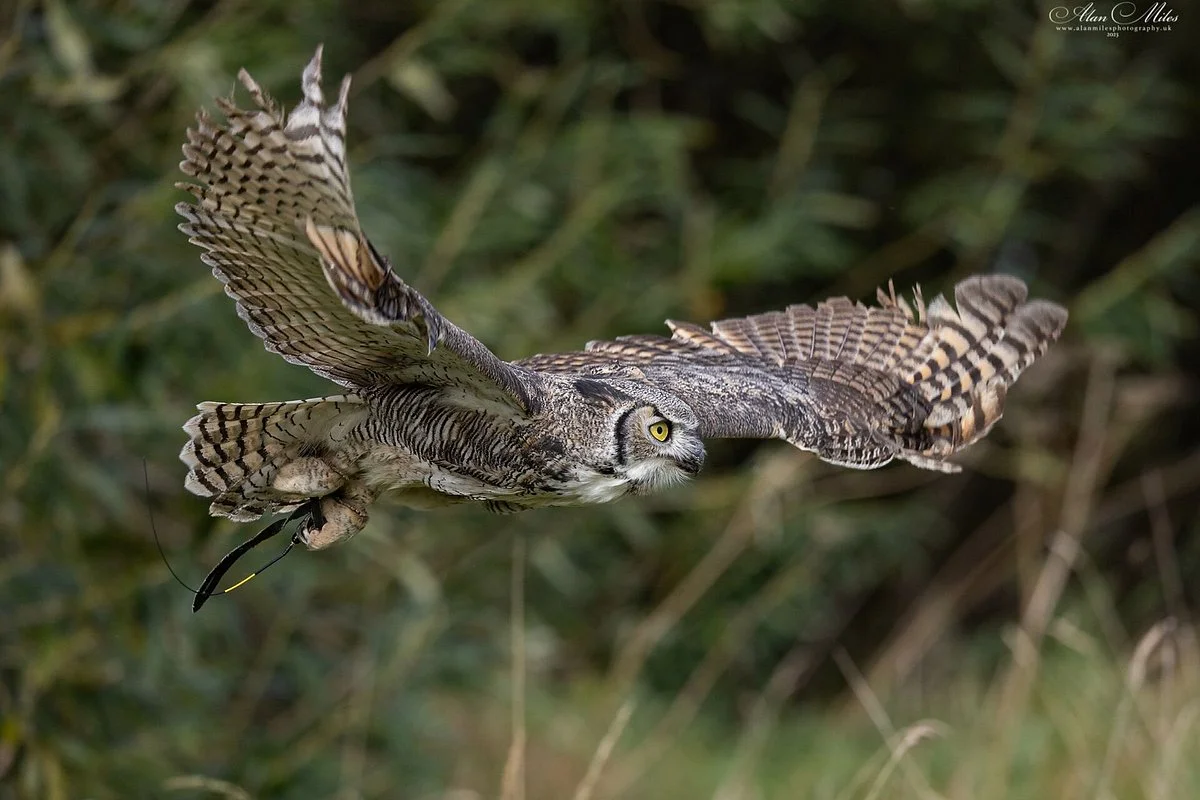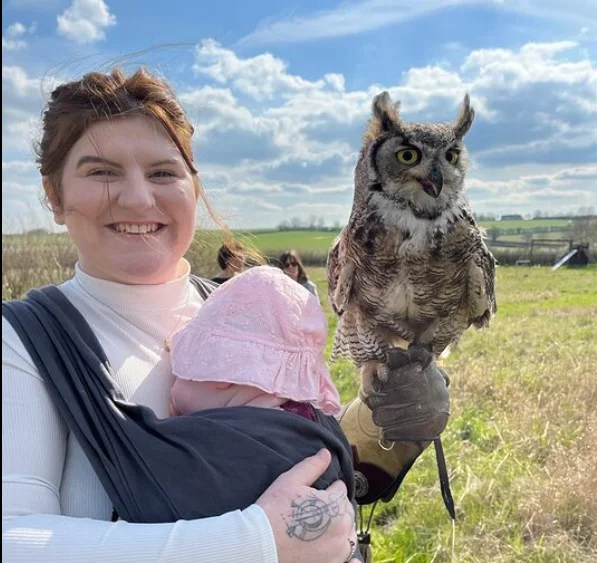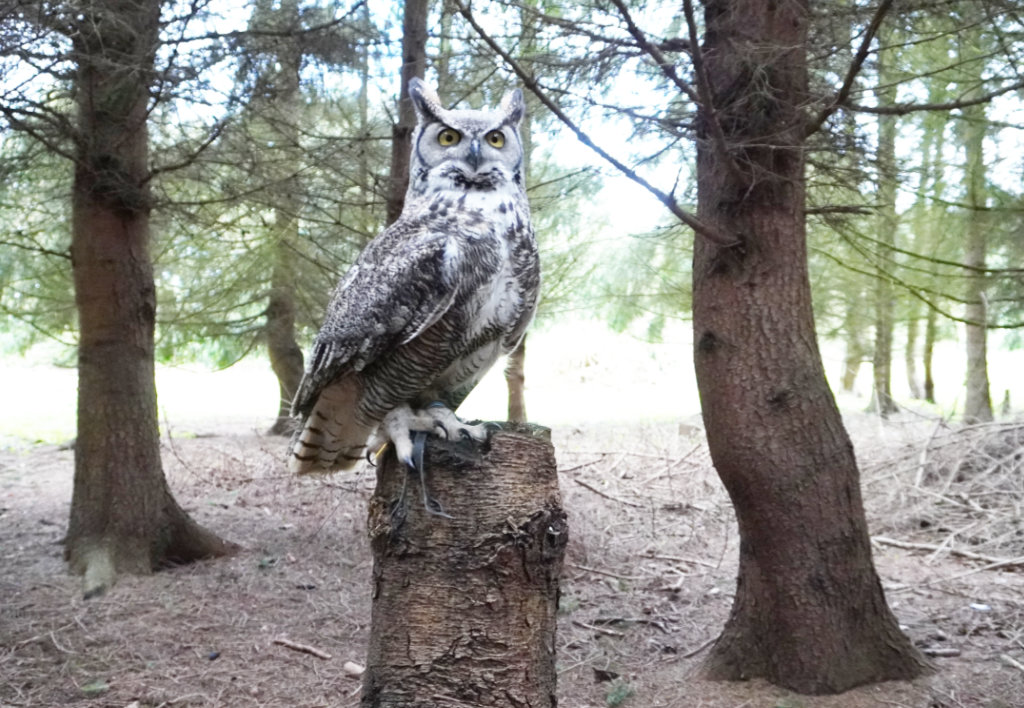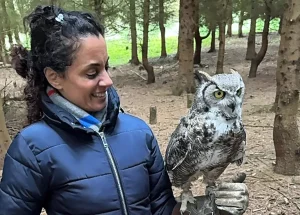The Great Horned Owl – Nature’s Fierce Night Hunter
Few birds capture the imagination quite like the Great Horned Owl. With its piercing yellow eyes, distinctive feather tufts and deep resonant hoot, this formidable raptor has earned nicknames such as the “tiger of the sky” and the “winged tiger.” To encounter one in the wild is to glimpse a creature that embodies both mystery and power, a bird that has inspired awe for centuries.
A Widespread and Adaptable Predator
The Great Horned Owl (Bubo virginianus) is one of the most widespread owls in the Americas, ranging from the frozen forests of Canada all the way down to the tip of South America. Few birds can boast such a wide distribution, and the secret to this success is adaptability.
This owl isn’t picky when it comes to habitat. Forests, deserts, grasslands, swamps, city parks and even suburban back gardens may provide a home, as long as there are tall trees or cliffs for nesting and a good supply of prey. In North America it is often the dominant nocturnal bird of prey, its booming hoots echoing across landscapes from wilderness areas to the edges of towns.
Appearance and First Impressions
The Great Horned Owl is a large and stocky bird, standing about two feet tall with a wingspan of up to five feet. Its mottled brown plumage makes excellent camouflage against tree bark, and the so-called “horns” are actually tufts of feathers that can be raised or lowered depending on mood. These tufts aren’t ears at all – the true ears are hidden, asymmetrically placed on the head to give the owl a remarkable ability to pinpoint sound.
Anyone who has ever looked into the eyes of a Great Horned Owl remembers the intensity. Those brilliant golden irises seem to pierce the darkness. The bird’s gaze has contributed to its reputation as wise, watchful and slightly intimidating.
A Hunter Built for the Night
The Great Horned Owl is a predator without equal in many of its habitats. It hunts mainly at night, relying on extraordinary vision and hearing. While humans struggle to see in the dark, the owl’s eyes are packed with light-sensitive rods that allow it to detect the faintest movements. Its ears can pick up the rustle of a mouse under leaves or even beneath snow.
What really makes this owl such a formidable hunter, however, is its silent flight. Specialised feathers break up turbulence and muffle the sound of air rushing over the wings, allowing the owl to glide on ghostly wings almost unheard. By the time prey realises something is approaching, it is usually too late.
The diet of the Great Horned Owl is astonishingly varied. It eats everything from rabbits, hares and rodents to snakes, skunks and even other birds of prey. Naturalists have found evidence of owls taking prey nearly as large as themselves – herons, ospreys, and on rare occasions even porcupines. This adaptability in hunting has helped the owl thrive in so many different environments.
Nesting and Family Life
Unlike many birds, Great Horned Owls rarely build their own nests. Instead, they take over abandoned nests of hawks, crows, herons or squirrels, sometimes adding only a little fresh greenery. They are early breeders, often laying eggs in late winter when snow still lies on the ground.
A typical clutch is two or three eggs, incubated by the female while the male brings food. The young owlets hatch covered in soft white down, growing rapidly into curious, wide-eyed youngsters. By the time spring is in full swing, they are scrambling around the branches near the nest, flapping their wings and preparing for their first flights.
There is a delightful term for these partly fledged young: “branchers.” Anyone lucky enough to observe them will see a comical mixture of fluff, oversized talons, and hesitant wingbeats. Though they may leave the nest before they can fly properly, their parents continue to feed them for weeks, sometimes months, until they can hunt on their own.
 The Voice of the Night
The Voice of the Night
Perhaps nothing is more evocative of the Great Horned Owl than its call: a series of deep, resonant hoots that carry for miles. The rhythm is often described as “hoo-h’HOO-hoo-hoo,” with the second note emphasized.
On a still winter’s night these hoots can seem haunting, even eerie, and it is little wonder that people across cultures have associated owls with the supernatural. Yet for the owls themselves, hooting is practical – a way of marking territory and strengthening the pair bond between mates.
Cultural Significance and Folklore
The Great Horned Owl has long held a place in human imagination. Indigenous peoples of the Americas often revered it with respect, sometimes fear, sometimes admiration. To some, its hoot was a warning of danger or death; to others, the owl was a powerful spirit guide.
In Aztec mythology, owls were companions of the god of death, Mictlantecuhtli, and their calls were thought to presage misfortune. Yet among the Lakota Sioux, the owl was also seen as a protector, a guardian of warriors.
European settlers arriving in North America brought with them their own associations of owls with wisdom and learning, rooted in the ancient Greek connection between the owl and the goddess Athena. Over time, the Great Horned Owl became a symbol both of wildness and mystery in the American landscape.
Stories of the owl’s fierce nature abound. Naturalist John James Audubon once recounted a Great Horned Owl attacking a full-grown wild turkey. Farmers in the past told tales of owls preying on poultry and even lambs, and so they were sometimes persecuted. Today, however, many people view them with admiration and delight when one is spotted in their neighbourhood.
Encounters and Anecdotes
For those who have heard the booming hoot of a Great Horned Owl in the stillness of night, the memory lingers. Birdwatchers often describe a sudden hush falling over the woods when the owl calls, as though smaller creatures know instinctively that a predator is near.
There are also accounts of owls defending their nests with remarkable ferocity. Hikers who have wandered too close during breeding season sometimes find themselves “dive-bombed” by an angry parent, an experience not soon forgotten. Their strength and determination are reminders that, for all our fascination, these are wild creatures deserving of respect.
The Owl in Today’s World
Despite habitat loss in some areas, the Great Horned Owl remains widespread and relatively common. Its ability to live near people, even in cities, has ensured its survival where other large birds of prey have declined. In some urban parks, the sight of a Great Horned Owl perched on a lamppost is becoming less unusual.
That said, owls still face threats from rodenticides (poisons used to control rats and mice), vehicle collisions, and the loss of nesting sites. Conservationists stress the importance of preserving wild areas and promoting safe pest control methods to ensure these magnificent hunters continue to thrive.
A Bird That Inspires Wonder
The Great Horned Owl embodies the wild spirit of the night. It is powerful yet elusive, common yet mysterious. From the frozen Canadian north to the deserts of South America, it remains a top predator, a guardian of balance in ecosystems, and a creature that stirs the human imagination.
Whether glimpsed gliding silently under the moon, heard calling across a snowy forest, or seen in the bright gaze of a captive bird in an educational setting, the Great Horned Owl commands attention. It reminds us that the natural world is full of wonder, and that even in our modern, noisy lives, there are still wild voices in the dark, echoing back through history and myth.
Where are Great Horned Owls found?
Great Horned Owls are found across North and South America, from Canadian forests to South American deserts. They thrive in forests, grasslands, wetlands and even cities.
Why is it called the Great Horned Owl?
The name comes from its prominent feather tufts, which look like horns. These tufts are not ears, but raised feathers that help with camouflage and communication.
What does a Great Horned Owl eat?
Great Horned Owls eat rabbits, rodents, snakes, skunks, birds and even porcupines. They are powerful hunters and among the most versatile raptors in the Americas.
Are Great Horned Owls dangerous to humans?
While they are not a threat to people, Great Horned Owls will fiercely defend their nests. Hikers sometimes report defensive swoops if they get too close during nesting season.
What does the call of a Great Horned Owl sound like?
Their call is a deep, rhythmic series of hoots, often in a five-note pattern. It carries long distances and is usually heard at night or early morning.




 The Voice of the Night
The Voice of the Night